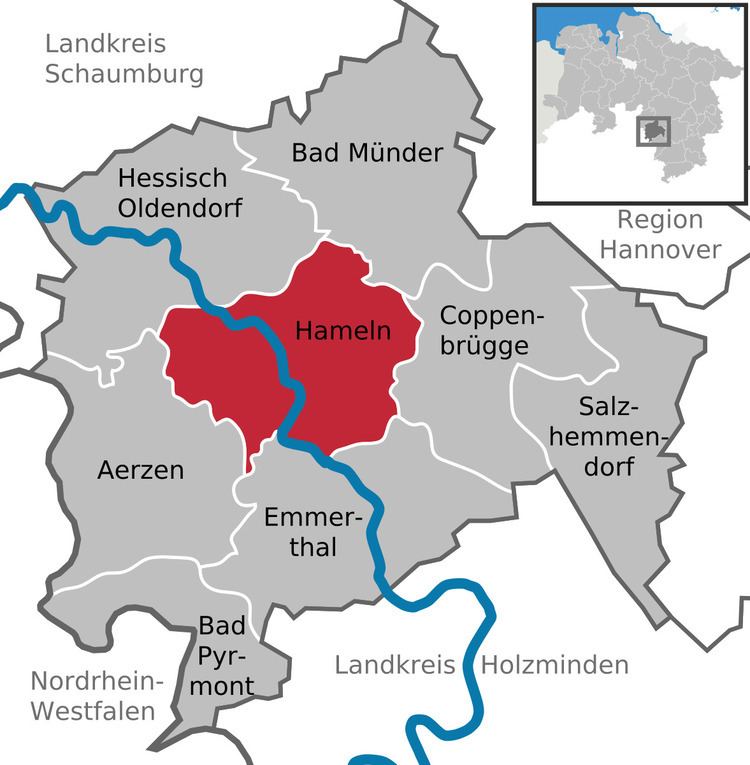Country Germany District Hamelin-Pyrmont Time zone CET/CEST (UTC+1/+2) Population 57,342 (31 Dec 2011) | Elevation 68 m (223 ft) Postal codes 31785–89, 3250 Local time Wednesday 12:34 PM | |
 | ||
Weather 12°C, Wind W at 13 km/h, 57% Humidity Points of interest Museum Hameln, Pied Piper Statue, MS “Warsteiner”, Bismarckturm | ||
Short visiting to the ancient hamelin city germany
Hamelin (/ˈhæməlᵻn/ or /ˈhæmlᵻn/; German: Hameln) is a town on the river Weser in Lower Saxony, Germany. It is the capital of the district of Hamelin-Pyrmont and has a population of roughly 56,000. Hamelin is best known for the tale of the Pied Piper of Hamelin.
Contents
- Short visiting to the ancient hamelin city germany
- Map of Hamelin Germany
- Rundgang durch hameln hamelin city tour
- History
- Subdivisions
- Tale of the Pied Piper
- Town twinning
- British army presence
- Notable people
- Notable events
- References
Map of Hamelin, Germany
Rundgang durch hameln hamelin city tour
History
Hamelin started with a monastery, which was founded as early as 851 AD. A village grew in the neighbourhood and had become a town by the 12th century. The incident with the "Pied Piper" (see below) is said to have happened in 1284 and may be based on a true event, although somewhat different from the tale. In the 15th and 16th centuries Hamelin was a minor member of the Hanseatic League.
In June 1634, during the Thirty Years' War, Lothar Dietrich, Freiherr of Bönninghausen, a General with the Imperial Army, lost the Battle of Oldendorf to the Swedish General Kniphausen, after Hamelin had been besieged by the Swedish army.
The era of the town's greatest prosperity began in 1664, when Hamelin became a fortified border town of the Principality of Calenberg. In 1705, it became part of the newly created Electorate of Brunswick-Lüneburg, also called Hanover, when George Louis, Prince of Calenberg, later King George I of Great Britain, inherited the Principality of Lüneburg.
Hamelin was surrounded by four fortresses, which gave it the nickname "Gibraltar of the North". It was the most heavily fortified town in the Electorate of Hanover. The first fort (Fort George) was built between 1760 and 1763, the second (Fort Wilhelm) in 1774, a third in 1784, and the last (called Fort Luise) was built in 1806.
In 1808, Hamelin surrendered without fighting to Napoleon, after his victory at the Battle of Jena-Auerstedt. Napoleon's forces subsequently pulled down the town's historic walls and guard towers. In 1843, the people of Hamelin built a sightseeing tower on the Klüt Hill, out of the ruins of Fort George. This tower is called the Klütturm and is a popular sight for tourists.
In 1867 Hamelin became part of the Kingdom of Prussia, which annexed Hanover in the aftermath of the Austro-Prussian War of 1866.
During the Second World War, Hamelin prison was used for the detention of Social Democrats, Communists, and other political prisoners. Around 200 died here; more died in April 1945, when the Nazis sent the prisoners on long marches, fearing the Allied advance. Just after the war, Hamelin prison was used by British Occupation Forces for the detention of Germans accused of war crimes. Following conviction, around 200 of them were hanged there, including Irma Grese, Josef Kramer, and over a dozen of the perpetrators of the Stalag Luft III murders. The prison has since been turned into a hotel.
The coat of arms (German: Wappen) of Hamelin depicts the St. Boniface Minster, the oldest church in the city.
Subdivisions
Tale of the Pied Piper
The town is famous for the folk tale of the Pied Piper of Hamelin (German: Der Rattenfänger von Hameln), a medieval story that tells of a tragedy that befell the town in the 13th century. The version written by the Brothers Grimm made it popular throughout the world; it is also the subject of well-known poems by Goethe and Robert Browning. In the summer every Sunday, the tale is performed by actors in the town centre.
Town twinning
Hamelin is twinned with:
British army presence
Hamelin was home to 28 Engineer Regiment until summer, 2014.
